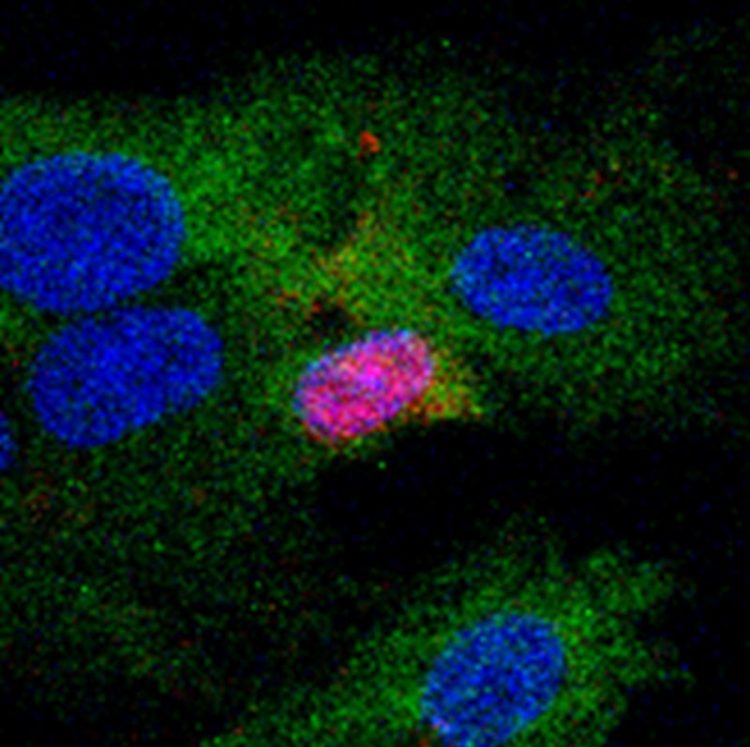Uncovering the Camouflage of the Hepatitis B Virus

Studies of the innate immune response following an HBV infection; blue: Cell nuclei from hepatocytes, red: core protein of the hepatis B virus (HBc antigen), green: Marker for immune activation (IRF-3). Image: R. König
The innate immune system is the first line of defence after infection by viruses and other pathogens. Molecular patterns typical of pathogens – so-called pathogen-associated molecular patterns (PAMPs) – are recognised by cellular pathogen recognition receptors (PRRs).
This opens signal pathways leading to immunological defence reactions of the body. In the case of virus infections, such molecular patterns frequently are the genetic information of the virus – RNA (ribonucleic acid) or DNA (deoxyribonucleic acid).
However, the pathogens have “learned”, too, and developed strategies of escaping the defence mechanisms. These include the inhibition of signal pathways of the innate immune response by viral proteins as well as shielding the viral genome from the “sensors” of the immune system.
Although the disease has been known for a long time, the treatment of chronic HBV infections is still limited to keeping the viral load low and the health effects as low as possible by permanently taking viralstatic drugs.
Curative treatments are not available. It is assumed that this would require the stimulation of specific immune cells against HBV in addition to the reduction of the viral load. To achieve this, we have to gain a better understanding, how the hepatitis B virus evades the successful defence of the immune system.
Researchers working in co-operation with Dr Renate König, head of Section Cellular Aspects of Pathogen-Host Interactions of the Paul-Ehrlich-Institut, in co-operation with other research groups from Germany have investigated this subject.
The genetic information of the HBV is present as DNA, and on the way to new virus particles, also as RNA. Both the RNA and the DNA of the HBV are potentially pathogen-associated molecular patterns, which could be recognised by the immune system. The research team investigated the immune-stimulating potential of the pure HBV-DNA and HBV-RNA in specific immune cells, dendritic cells derived from monocytes (MDDCs).
In doing so, they were able to show for the first time that HBV-RNA does not act in an immune-stimulating manner, while HBV-DNA does. HBV-DNA induces a strong innate immune response via a specific signal pathway, which is also present in liver cells (hepatocytes).
At the same time, the research team established that this signal pathway is not activated during a manifested HBV infection although, according to the data, the virus is not actively suppressing it. The researchers assume that the viral DNA is protected from the recognition by the immune system by the capsid – the virus envelope.
One possible approach to wake up the immune system for the defence against the HBV could be to damage the capsid structure of the virus, thus making the virus DNA “visible”.
Blood safety – vaccines – research: the Paul-Ehrlich-Institut's three-fold strategy for protection against Hepatitis B
Basic research is not the only activity into which the Paul-Ehrlich-Institut is involved in an effort to combat HBV. Blood is one of the main transmission routes of HBV, and the Paul-Ehrlich-Institut is responsible for the safety of blood and blood products in Germany.
Together with the German Medical Association (Bundesärztekammer), it determines the guidelines for the manufacture and use of blood products. Besides, the Paul-Ehrlich-Institut systematically records adverse events in the manufacture of blood components as well as serious adverse reactions in the donor or the blood recipient as part of its haemovigilance activities.
If a risk is identified, the PEI takes action to bring about the necessary protection. The reports on adverse events and reactions are published regularly in the haemovigilance report of the PEI. Thanks to the extensive protective measures, which also include testing all blood donations for HBV (HbsAg, anti-Hbc), in the periods of 2016 and 2017, no single case of a confirmed HBV transmission was reported in Germany.
The most effective protection against hepatitis B is the HBV vaccination. In Germany, the Paul-Ehrlich-Institut is also responsible for the safety and efficacy for human and veterinary vaccines, thus contributing to public health.
Lauterbach-Rivière L, Bergez M, Mönch S, Qu B, Riess M, Vondran FWR, Liese J, Hornung V, Urban S, König R (2020): Hepatitis B Virus DNA Is a Substrate for the cGAS/STING Pathway but Is Not Sensed in Infected Hepatocytes.
Viruses 12: E592.
https://www.mdpi.com/1999-4915/12/6/592 – Fulltext (Open Access)
http://www.pei.de/EN/newsroom/press-releases/year/2020/11-uncovering-camouflage-… – The Press Release on the PEI-Website
Media Contact
All latest news from the category: Life Sciences and Chemistry
Articles and reports from the Life Sciences and chemistry area deal with applied and basic research into modern biology, chemistry and human medicine.
Valuable information can be found on a range of life sciences fields including bacteriology, biochemistry, bionics, bioinformatics, biophysics, biotechnology, genetics, geobotany, human biology, marine biology, microbiology, molecular biology, cellular biology, zoology, bioinorganic chemistry, microchemistry and environmental chemistry.
Newest articles

Pinpointing hydrogen isotopes in titanium hydride nanofilms
Although it is the smallest and lightest atom, hydrogen can have a big impact by infiltrating other materials and affecting their properties, such as superconductivity and metal-insulator-transitions. Now, researchers from…

A new way of entangling light and sound
For a wide variety of emerging quantum technologies, such as secure quantum communications and quantum computing, quantum entanglement is a prerequisite. Scientists at the Max-Planck-Institute for the Science of Light…

Telescope for NASA’s Roman Mission complete, delivered to Goddard
NASA’s Nancy Grace Roman Space Telescope is one giant step closer to unlocking the mysteries of the universe. The mission has now received its final major delivery: the Optical Telescope…



